So I visited the History Museum in Hanoi a few weeks ago where they currently have a small (but wonderful) exhibit marking 70 years since the discovery of the first Đông Sơn artifacts.
On the one hand, it was fantastic to be able to stand next to a bronze drum and to examine it closely.
On the other hand, as I looked closely at some of the artifacts on display, I felt as if I had been betrayed by the scholars who have written about Đông Sơn culture, as there is obviously so much more to say about Đông Sơn culture than scholars have discussed to date.
For instance, while apparently some scholars have noted that there are images of people engaging in sexual intercourse on some Đông Sơn bronze artifacts, I never realized that those images were on burial jars.
This is incredibly significant because this links the Đông Sơn culture to a larger (non-Việt) world, as in as late as the twentieth century (and perhaps today as well) Austronesian-language speakers like the Jarai placed similar images on their tombs.
Another image that surprised me was the presence of water buffalo on bronze drums.
A great deal has been written about the images of birds on bronze drums, and numerous Vietnamese scholars have argued that these birds represent the “totem” of the “Lạc” people, a people whom Vietnamese scholars claim were the original inhabitants of the Red River delta. But there are water buffalo on bronze drums too, so why don’t people talk about the water buffalo as a totem of the “Lạc” people?
I was also surprised to find beautiful bells.
The elephant image on this bell is exquisite.
The Chinese characters on this bell, meanwhile, lead to interesting questions.
As Han Xiaorong pointed out years ago, Vietnamese and Chinese scholars have spent much of the past half century claiming that the bronze drums (and by extension, Đông Sơn culture) were “Vietnamese” or “Chinese” (“Who Invented the Bronze Drum? Nationalism, Politics, and a Sino-Vietnamese Archaeological Debate of the 1970s and 1980s,” Asian Perspectives, 43.1 (2004): 7-33.). The historical reality, however does not match current national borders.
The couple engaging in sexual intercourse on a funerary jar, the water buffalo, the elephant, and Chinese writing all indicate this. Instead, what we find on bronze objects in the area stretching from the Yangzi to the Cả River is evidence of an elite cultural world where members of the elite across this vast region interacted and exchanged objects (and perhaps ideas) with each other.
This article by Wei Weiyan, Shiung Chung-Ching- “Viet Khe Burial 2: Identifying the Exotic Bronze Wares and Assessing Cultural Contact between the Dong Son and Yue Cultures,” Asian Archaeology 2 (2014): 77-92 – makes this point.
These authors find that there are objects in a tomb in an area near what is today Hải Phòng that clearly came from areas to the north, but that one can also find a dagger like those in the images above and below that was representative of the Đông Sơn culture that has been found in a tomb in Hunan.
So what all of this indicates is that there was a world in the first millennium BC that was sophisticated, but which was neither “Vietnamese” nor “Chinese” and which was not the “origin” of “Vietnamese” or “Chinese” history.
It is a past world that has disappeared. While we can never fully recover that past world, we can still learn a lot about it if we put aside the need to find “Vietnamese” or “Chinese” history at this time, and if we just look at the water buffalos, the elephants, the daggers and the people engaging in sexual intercourse on their own terms.
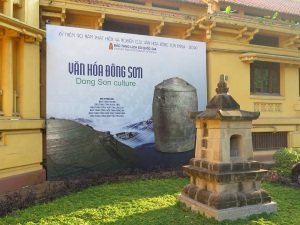

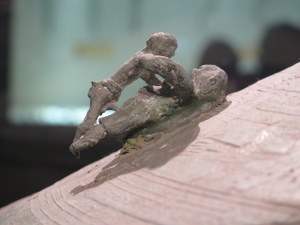
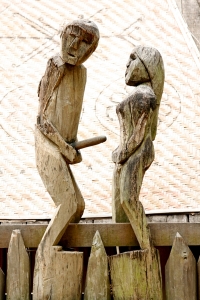
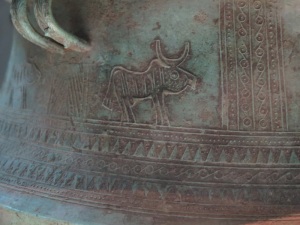
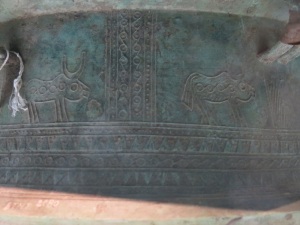
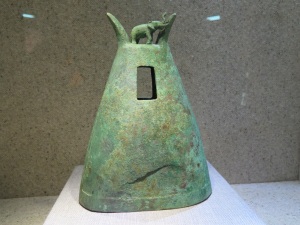
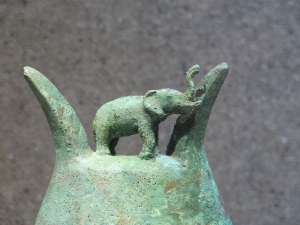

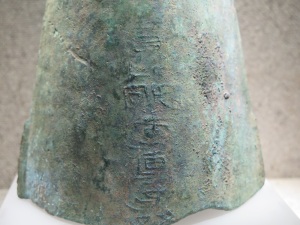
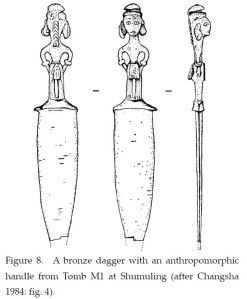
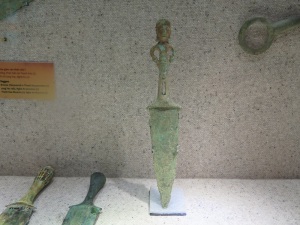
Great illustrations for the points you make. Do the classic articles on Dong Son drums simply reproduce the same images from “important” drums? Much of what you photographed is new imagery to me. It’s not like I’ve kept up with the new literature, but I thought I knew what those drums were. Your pics open a new world…
The circular design that is on the top of many bronze drums and the bird image that is on some bronze drums are the two images that have been repeated the most.
The bird image was the topic of a big debate in the late 1950s/early 1960s in North Vietnam. Scholars argued that it was a totem, but they couldn’t agree on what kind of bird it was. That symbol, however, has become widespread. If you do a Google image search for “chim lac” (“lac bird”) you will see it.
I think the big problem is that Vietnamese scholars in the past tried hard to create an image of a single/unified culture which could serve as the origin of a single/unified Vietnamese nation, but the bronze drums clearly demonstrate cultural variety.
The article by the Chinese authors that I mention in the post uses the idea of 3 different culture areas that were in interaction with each other (corresponding to what is today roughly the areas of the Red River delta, southern China, and areas in eastern China south of the Yangzi), but I wonder if a close examination of the imagery on bronze drums would suggest that within those larger areas there were distinct cultures as well.
Chk, ôi trời, you have a lot of time to pussyfoot around mate! You know the mantra: Vietnamese were cave dwelling barbarians who got civilized by the Chinese, so everything came from them. The British used to say that Australia was terra nullius. The world has already woken up and see through the length and depth of many lies and deceits that various imperialist powers have implemented, and we Vietnamese are supposed to rely on the Chinese’ words and texts to tell our history.
I find it amusing that the Chinese try to claim the Erlitou site as the proof of Huaxia, since the layout of construction plan were replicated by later dynasties as still can be seen at the Forbidden City built by during the Ming dynasty. They forgot to tell people that in 1406 the Ming invaded us, captured our engineers and tradesmen to build the palace for them. These Han descendants Huaxia did not know how to design and build it, and had to rely on the Vietnamese? In whose architectural style was it built again? Oh no, the Vietnamese barbarians learned from the Chinese and stole from them!! Since everything is “Chinese” or ‘came from the north’ except for the people regardless of what the genetic evidence say, it’d seem pointless to try to find something as ‘Vietnamese’ then.
The scholars focused on the birds because they thought that ‘Lạc’ refers to the bird, but ‘Lạc’ in ‘Lac Viet’ means lake; not to be mistaken with ‘Lạc’ in ”Lạc Quȃn’ which means warrior, hero, denoting respectable status. Part of our ancestry is from an early wave of migrants from Lạc Hà in Henan, who migrated south long before the alleged Huaxia started.
‘Lạc’ denoting high status might have come from the bird, since birds were very important guides for navigation, forecasting weather and season, growing crops etc., not to mention the cool ones which are trained to do the fishing; hence many Baiyue people used them as totem or art decoration along with buffaloes. ‘Lạc’ in ”Lạc điền’ means lạch, water channel and related or similar water structure. ‘Lạch’, ‘hồ’ and ‘hà’ have the same origin with ‘lake’, but people are trained to believe that the Chinese gave the words to the Vietnamese. Vietnamese are Kinh Viet, ‘kinh’ coming from the same origin with Irish ‘cinn’ meaning head, means capital as you know; the Capital Viet is cosmopolitan Viet, made up of a blend of Yao, Miao, Zhuang etc., it’s fool hardy for archaeologists to insist on finding something completely unrelated to those people as a must, to call it Vietnamese or as Vietnamese heritage, and reject anything that is related to those ethnics. One might say that modern Vietnamese culture is not the same as the old cultures, but too often people dismiss them as not a part of our heritage and belong solely to the people in China.
The buffalo is an interesting one. It’s a very big thing with the Miêu, whom we are related to. Chiyou had horns, Laotzu rode the buffalo to the west, Moses face was horned when he came down from the mountain; and yes, horn is the right translation along with radiance, since the horn represents the moon crescent. They all were buffalo soldiers, shepherds of the herds. This reminds me of your last name, I assume that it is Lê which means Levi. 黎, a person 人; arises from water 水, thủy, suối; bringing or carrying benefit, lợi, 𥝢 or 利. I don’t see the character representing anything to mean black, nor is there any connection to Han culture who had supposedly invented the script, in the way the character was constructed, unless it was used as phonetic correlation. It’s no mystery why the Night Yue, Yelang swore allegiance to the Southern Yue rather than with the Han. The legend of their king is told in the tradition of Moses, a baby from a river who became king and broke a rock which created a river flow. I’m sure you’ve already known that Moses means drawn from water, and water represents knowledge. I do not equate this to our people coming from the lost tribes of Israel, because our history is much older than those biblical times, as far as we know.
Back to the word Lê, maybe it’s because the 9 Li were black people right? Which is a curious thing since up to the 1800s, they were still hunting down blonde haired descendants of people from the 9 Li to exterminate them in China; regardless of whom people want to blame the crimes on, those victims were not black. The 9 Li originally referred to the 9 kins of heavens, identifiable by their spiritual or cultural expressions, not by colour of skin or race. Nevertheless, using the word for black helps repelling many white wannabes from claiming association with the 9 Li, it still works until this day. Lê in ‘lê dân’ means the multitude, not black. The fakeass interpretations of ‘lê dân’ as black people, and ‘Hoàng Ðế’ as some light skin, or yellow skinned person, or blonde hair Aryan has help the imperialists with their expansions, wars, divide and conquer ploys till this day.
The word ‘Hoàng’ meaning royal , shares the same root with the word ‘tankam’, meaning gold in Tamil. ‘Arya’ meaning noble has root in the Welsh word ‘aur’ (pronounced as ai’r) meaning gold. The Vietnamese say “anh” and the Irish say “án” for bright, brilliant; splendid, noble. The German say adelig, edel, adlig for noble; the Swedish say adlig, ädel; the Dutch, Danish and Norwegian say similar words, the old Irish said arg. Often, the ‘r’ in ancient time is a soft trill like the Japanese ‘r’ which can sound like d or l and easily spotted in variation of sounds between languages; obviously the term ‘arya’ or ‘airya’ is not some exclusive term from India referring to the imaginary Aryan invaders. Remind us of how many so called ‘Aryans’ or ‘civilised Christians’ killed each others in the last two world wars and today again, that makes them more superior and feel the need to spread their civilisation to make the rest of the world civilised people, and everyone should be grateful.
Speaking of imperialism, the Chinese are hilarious. They boast about their great empire and how they subjugate other people, then complain about what the evil Western and Japanese imperialists have done to them. On the one hand they say Zheng He brought message of peace from China to the world, they are peaceful people and is no threat, on the other hand they boast about how powerful their fleet was at invading Sri Lanka and subjugating other countries into paying them tributes. The self-proclaimed ‘white’ people of Huaxia must really be superior and have grown double tongue, they can twist reality any way they want to.
Despite the obvious connection between Vietnamese and other ethnics in China, the cong, the bronze drums and the art motifs, genetic relation, linguistic relation; our language have plenty of words from the same origin with Hmong-Mien as well as Tai-Ka Dai, a lot more than linguists have portrayed; but no, Vietnamese are not allowed to claim any current or previous connection to other people, nor any part the land as part of Vietnamese history in the past, because the other ethnics are different and speak different languages. But, only Chinese are allowed to claim Vietnam and other lands which were and are inhabited by peoples of different ethnics as part of their territory in Chinese history.
Only the Hans are allowed to claim Tibetan and any other ethnic they wish to claim as related to them, or as Chinese; but Yue peoples were all different, they were all unrelated. Everyone should be grateful to the Han/Huaxia people who evolved separate from other people, had spread out and civilised the surrounding barbarians. Considering there were already civilisations older than Huaxia found in the surrounding areas, the great Huaxia people must have invented time machine, went back in time and civilised those people too.
These Huaxia people, who’ve always been in power except for those brief times of Mongol, Jing and Japanese domination, have difficulty pointing out where the Huaxia site was located. Never mind the Chu whose arts were quite Celtic with a soft layer of Baiyue, and spoke a kind of Hmong-Mien language, they still were Huaxia or Han. Same with the Shang, who did not even mention their own supposedly Huaxia civilisation in their history, whose language was kind of Austro-Asiatic and sounds similar to Khmer like us niggers in the south; but as you know the superior double tongue can twist and make them the people from Huaxia whereas the barbarian Vietnamese cannot make any claim in any remotely similar circumstances.
Then again, Vietnamese should be grateful. The Chinese must have spent gazillion pounds of gold to educate us barbarians to sound just like classical Chinese speakers while neglecting their own people which is why the Chinese now sound kind of Creole. They also let us steal from their culture and claim Shennong as our ancestor, they even say Shennong in our word order rather than Nongshen just to make us feel better.
They stuck at it with us for almost a thousand years, erased our history so then we could become civilised Han but we kind of rebelled a little bit too early. A king once said, this is a battle of a thousand years to win over the people, I can’t remember the name but you must have read that passage before, I think it might have been attributed to Huangdi, or could be Qin Shi Huang or Liu Bang. It would be foolish for Vietnamese and Yue peoples to expect to find much traces of the past given the occupation by the Han. The key question is whether Ngo Si Lien concealed details, or he mistakenly pointed out important sites which enables some people to find and destroy them, as well as having their own cultural revolutions, burning books and write a different and contradicting historical account. I’m not referring to the Han exclusively.
Ngo’s dating of the Kinh Duong era and the Lac Long era is very accurate though. The genetic studies so far corroborate with our history which I won’t elaborate. But, knowing how advanced and best at counterfeit products China can produce, the Chinese government can produce new evidence anytime to support their claims. What happened from the start of the Van Lang era until Au Lac is hard to know. The best thing he could do was to state the 18 kings to indicate that we came from 9 Li, and avoid revealing things that could invite the invaders to come to burn our books, kill our people to erase history again.
Van entails all meanings of letter or literate, civilised, cultured, painting, arts and tattoo. It’s not hard to find out ‘Van’ and ‘Lang’ share origin with Sanskrit and European languages; the Huaxia people must have forgot to write in their history that they’d travelled far, civilised the Indians and Europeans and gave them words. We’ve had our own script long ago, but no, Vietnamese were civilised and taught words and writings by the Han. Unfortunately, a large part of the history of China was CONVENIENTLY erased not by the Han, but by the evil Qin and the Chu people. Their heroic righteous ancestor Huangdi (who had a drought demon for a daughter, go figure that one out, it must be the source of the double tongue) was pushed by the evil Chiyou, and came to the rescue. The people from Chiyou, Yu, and Yandi carried ancestral enmity, except the Huangdi people who were righteous and rescued everyone.
Those so called ‘Chinese’ script on the bell makes me imagine that after some world catastrophe in the future which have wiped out most of mankind, some archaeologist digs up some fragments in Switzerland and concludes that it was some civilisation called British since they used the English language and English script since nobody has ever heard of Latin script. Listening to some audio of the two so called dialects Mandarin and Wuyue, and two different languages Swedish and Norwegian, then concludes what about them? Very ancient Bronze Drums found buried all along from Vietnam to Lake Dongting, then what would the archaeologist be thinking?
This is getting too long, I must wrap this up. One thing I know for sure, is that our ‘violent barbarians’ Viet/Yue ancestors in the south always had to receive refugees running away from the ‘civilised’ Han/Huaxia people in the north. Yao, Miao, Zhuang etc. are all in our DNA, our ancestors carried the pains the invaders inflicted on them, they were not myths or imaginary. I do not hold any grudge against the Chinese people, some of my relatives are Chinese and they are fine people. What one needs to consider is that if we continue allowing the same circular education system that has brainwashed people over the last 2,000 years to perpetuate, they will eventually swallow up all other ethnics like they have done in the past thousands years; the system is rigged, people who repeat what they want them to say get rewards, those who stand up for the truth often get ignored or might even find themselves in trouble. They also have their billion of brainwashed people to repeat the same crap all over the world. Furthermore, there are a few more questions worth exploring:
1)What changes happened to Vietnamese society after the Qing took over China and caused many people to move to our territory from that time onwards? , The ‘phản Thanh phục Minh’ campaign in China went nowhere. Considering how corrupt the Nguyễn Ánh family was, causing havoc in the southern Vietnam; he had Chinese pirates and Khmer mercenaries to help his campaign to make our land Han’s territory calling us Han people and other peoples barbarians, while king Quang Trung died in a mysterious death when he was about to destroy the traitor. What Chinese influences were there on the Vietnamese elites? Many innocent Chinese who had nothing to do with politics died when the Tây Sơn troop massacred the Chinese town out of anger, but if they had intention of wiping out the Chinese then massacre would have been widespread.
2)The allegation that Nguyễn Ái Quốc died in 1932 and Hồ Chί Minh was a Chinese named Hồ Thập Chương planted by the Chinese communist could be true. This might explain the VC purging of the Chinese in the 70s, giving them the choice of either taking up Vietnamese citizenship or leave; they found out the truth and the Chinese’ plan to incorporate Vietnam into China. The VCs probably are not interested in involving too much with Cambodia but they cannot take the chance of another Pol Pot installed by the Han. The Vietnamese get the blame when it was the Chinese and the British governments who kept the Khmer people suffer for a long time when the issue could have been resolved earlier. It was a Cantonese lord who inflicted cruelty on the Khmer but the Vietnamese got the blame for it; anyhow is there any possible path for Vietnam to be not too involved with Cambodia without security threat? Also, from the time of the Ming dynasty in 1400s onwards, was there any backdoor deal among the elites, or plan to slowly turn Vietnamese into Han? There is no intention here to whitewash any crime that some of the Vietnamese especially the elites have done in the past, I’m sure there have been corruptions and failings at certain times. However, reality is not always what it seems to be or how it is presented.
@ Duong Ngô : you write ” reality is not always what it seems to be or how it is presented ”
How relevant ! you should read this post Demystifying Mainland SEA https://leminhkhai.wordpress.com/2013/10/07/demystifying-mainland-southeast-asia/
” China ” or ” Vietnam ” are not always what they seem .
A book (quote ) [ was published a year ago called Demystifying China: New Understandings of Chinese History. It contains 24 chapters and the authors of each chapter attempt to challenge many assumptions that people have about China, such as the assumption that there has always been a unified and clearly defined place and people that we can safely refer to as “China” and “the Chinese,” respectively.
“One of modern China’s most powerful ideas has asserted that the Chinese people have formed a single collective unit from ancient times through the present. This nationalist claim of primordial unity still retains a strong grip on academic history and popular consciousness.
Perdue then goes on to look at, and challenge, various aspects of the view that “the Chinese people have formed a single collective unit from ancient times through the present.” He notes, for instance, that “Genetic evidence does not indicate that all citizens of contemporary China descended from a common ancestor.”
He also points out that “Modern archaeology also does not support the thesis of a single people inhabiting the territory of modern China,” but instead, that modern archaeologists have come to realize that there were “multiple centers” in antiquity in the area that we now refer to as “China.”
Perdue then notes that “Such evidence for multiple centers of cultural innovation undermines the idea of essential unity that supports the notion of a single people. . . Chinese and Western archaeologists still debate the extent to which these multiple cultures formed a single ‘interaction sphere,’ but the assumption of a blended, uniform culture from ancient times has no empirical support.”]( unquote )
Such an unified and clearly defined place and people called Vietnam did’nt either exist .
One should read :
http://vi.wikipedia.org/wiki/B%C3%A1ch_Vi%E1%BB%87t about the ” Bach viêt ” In it , is stated that 2 kingdoms named Ngô and Viêt sprang from the political and cultural interaction of Bach Viet and ” pre – Tsin ” ” Chinese
and took part in the Warring States multiple contests ; they were , as Perdue would say ,two of the ” multiple centers ” of Han culture .
The Wikipedia article also says that Bach Viêt culture has made contributions to the ” Chinese ” culture that we know of today
Quote [Dấu vết của ngôn ngữ Việt, đặc biệt là cấu trúc “tính từ đi sau danh từ” (ngược lại với tiếng Trung Quốc) vẫn còn lại trong các tác phẩm văn thơ kinh điển của Trung Quốc như Kinh Thi[10], và trong tên gọi của các vị thần/vương truyền thuyết mà người Trung Quốc coi là của họ như Thần Nông, Đế Nghiêu, Đế Thuấn, Đế Khốc
Một số học giả cho rằng Kinh Dịch là sản phẩm của nền văn minh Thần Nông ở phía Nam sông Dương Tử (nghĩa là thuộc vùng đất Bách Việt). Có người còn khẳng định cụ thể hơn rằng đây là sản phẩm của người Âu Việt và Lạc Việt , với các lập luận chẳng hạn như: có thể thấy các khái niệm Kinh Dịch được mã hóa trên các họa tiết trống đồng; một số tên quẻ cũng như diễn giải quẻ của người Trung Quốc từ xưa tới nay đôi khi còn rất mơ hồ…] ( unquote )
So the conception that China and Vietnam existed ever since the beginning of history and that they are locked in enduring enmity should be discarded . Today Vietnam and China were parts of “multiple cultural centers ” and today ” Chinese ” culture is a mixture of Bach Viêt – Han one
@Duong Ngo : China – VN confrontation is debunked by US historians in this post https://leminhkhai.wordpress.com/2014/12/13/the-idea-of-a-vietnamese-pantheon/#comment-47862
These are topics that have been discussed a bit by Nam Kim (in a recent conference paper at the Assoc. for Asian Studies meeting 2014). You might enjoy some of his work:
Kim, Nam, Lai Van Toi, and Trinh Hoang Hiep
2010 Co Loa: an investigation of Vietnam’s ancient capital. Antiquity 84(326):1011-1027.
Kim, Nam C.
2013 Lasting Monuments and Durable Institutions: Labor, Urbanism, and Statehood in Northern Vietnam and Beyond. Journal of Archaeological Research 21(3):217-267.
Thanks for pointing this out!! Yes, Nam Kim’s work on Co Loa is very important. In examining the wall around Co Loa, if I remember correctly, he shows that there were several (I think 3) stages of construction, and that some aspects of the construction are similar to citadel wall construction in areas to the north (in what is today southern China).
The work of other archaeologists is also showing that there were interactions between the Red River delta and areas to the north long before “the first Chinese conquest” of the region. I find all of this work to be fascinating.
Judith Cameron, “Textile Crafts in the Gulf of Tongking: The Intersection of Archaeology and History.”
Marc Oxenham et al., http://press.anu.edu.au/titles/terra-australis/ta33_citation/pdf-download/
Ah yes! Judith Cameron has done lots of interesting work- thanks! I also appreciate you posting so many wonderful photos of the drums and associated artifacts.
I’m so sick of all the pro-chinese nutcase who claimed they “educated “and “civilised” Viet Nam out of the Dark Age. If so, why did primitive china invaded and destroyed the more advanced Vietnamese’s Dong Son culture / civilisation circa 700BCE- 100BCE? China also stole valuable intellectual property and artifacts from the Dong Son area, particularly the art of bronze casting and weaponry. After the chinese invasion, china suddenly had an explosion in copper manufacturing and weaponry like the “chinese” crossbow – a shameful, unacknowledged ripoff carbon copy of Dong Son’s rapid-fire crossbow. Fancy that, huh?! So, I don’t believe in any of these so-called chinese “historians” anymore since history, more often than not, is written by the victor to suit the victor’s agenda!
Enough said.